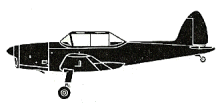
ASN Wikibase Occurrence # 139874
This information is added by users of ASN. Neither ASN nor the Flight Safety Foundation are responsible for the completeness or correctness of this information.
If you feel this information is incomplete or incorrect, you can submit corrected information.
| Date: | Saturday 27 January 1968 |
| Time: | |
| Type: |  de Havilland Canada DHC-1 Chipmunk 22 |
| Owner/operator: | Royal Aero Club of New South Wales |
| Registration: | VH-FTA |
| MSN: | C1/0499 |
| Fatalities: | Fatalities: 2 / Occupants: 2 |
| Aircraft damage: | Destroyed |
| Category: | Accident |
| Location: | Cobbitty, near Camden, NSW -
 Australia Australia
|
| Phase: | Manoeuvring (airshow, firefighting, ag.ops.) |
| Nature: | Training |
| Departure airport: | Bankstown Airport, NSW (BWU/YSBK) |
| Bankstown, Sydney, NSW (BWU/YSBK) | |
| Confidence Rating: |
Ex-RAF Chipmunk WG425: delivered 15/10/1951, service with 4 FTS, Heany, Southern Rhodesia. Struck off charge when sold 29/10/1953 at 394 MU Heany. VH-FTA was acquired the Royal Aero Club of NSW in 1955.
VH-FTA crashed on 27/1/1968 at Cobbitty, near Camden, killing Royal Aero Club of NSW Instructor Arthur Kell, DFC and Bar, and his student, who had gone out to do a session of spins. The subsequent investigation revealed that a 20-cent coin had fallen out of the pilot's pocket whilst the aircraft was inverted and jammed the controls, preventing the stick from moving.
It was ironic that Arthur Kell had survived all the Germans had thrown at him during WW II, but was killed by a coin someone had lost in the cockpit. Moral: Never do aerobatics with anything in your pockets!
The leather or canvas boot around the base of the stick was in poor condition thus allowing the coin to enter. Post accident there was a nation wide flurry of activity to rectify similar wear and tear on other Chipmunks. The problem was exacerbated by the practice in those days of removing the rear stick for solo flights thus leaving a gaping hole for objects to enter the under floor area.
Sources:
1. Royal Air Force Aircraft WA100-WZ999 James J Halley, Air Britain 1983 p.44)
2. http://www.edcoatescollection.com/ac1/austcl/VH-FTA.html
3. http://www.ukserials.com/results.php?serial=WG
4. https://www.pprune.org/aviation-history-nostalgia/385363-chipmunk-beautiful-8.html
5. http://www.ukserials.com/losses_civil.htm
Images:

Photo: Department of Civil Aviation, Australia

Wallacia, NSW. Sept 1965
Revision history:
| Date/time | Contributor | Updates |
|---|---|---|
| 13-Nov-2011 13:23 | Dr. John Smith | Added |
| 09-Feb-2013 01:03 | Dick | Updated [Narrative] |
| 09-Feb-2013 01:03 | Anon. | Updated [Narrative] |
| 01-Apr-2014 00:12 | Dr. John Smith | Updated [Departure airport, Destination airport, Source, Narrative] |
| 06-Nov-2018 20:47 | harro | Updated [Photo] |
| 25-Feb-2020 17:49 | Warwick Henry | Updated [Photo] |
| 25-Feb-2020 17:51 | harro | Updated [Source, Narrative] |
| 14-Jan-2021 20:52 | Anon. | Updated [Nature] |
| 15-Mar-2022 06:24 | Anon. | Updated [Narrative] |
| 08-Jun-2022 07:38 | Ron Averes | Updated [Location] |
Corrections or additions? ... Edit this accident description
The Aviation Safety Network is an exclusive service provided by:


 ©2024 Flight Safety Foundation
©2024 Flight Safety Foundation